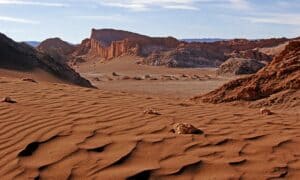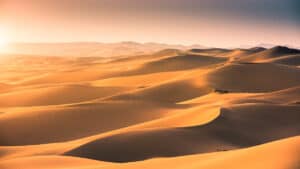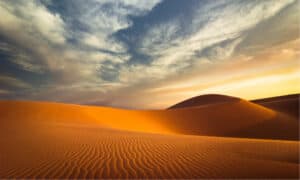The planet is full of natural wonders. Whether you are looking at the top of the highest mountain or the bottom of the deepest ocean, the way everything works together to create an ecosystem is amazing.
One type of environment that is particularly fascinating is the desert. There are several different types of circumstances that can create a desert, and there are deserts all over the world. Far from being barren environments, the case is actually that many organisms have adapted to life in the desert.
But just which desert is the most impressive? If we look at the continent of Africa, for example, there are many desert environments worth noting. Read on to learn more about the largest desert in Africa!
What Is a Desert?
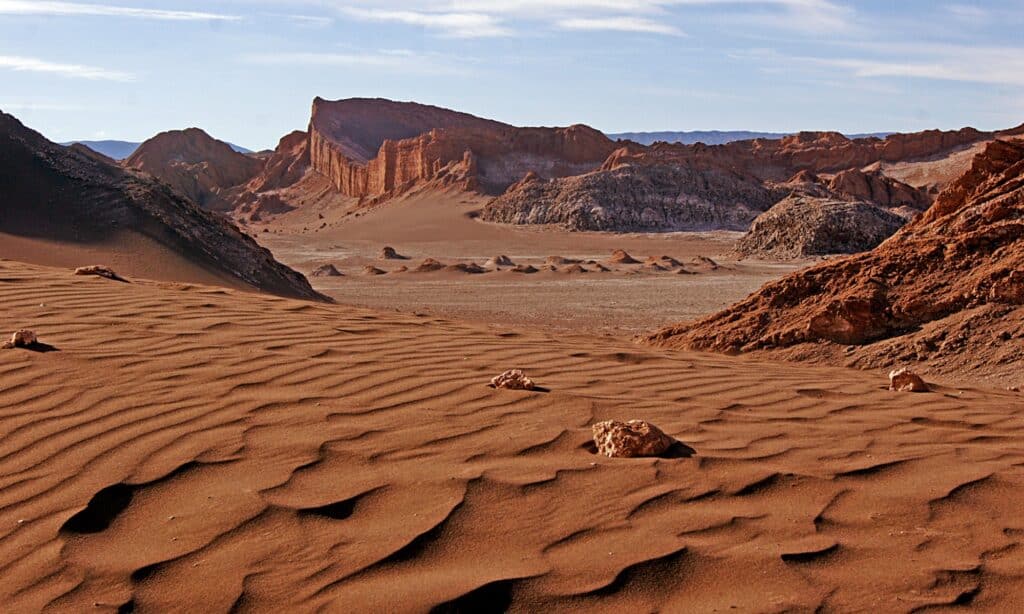
A desert is an area that receives very little precipitation.
©iStock.com/Eduardo Cabanas
Simply put, a desert is an area that receives very little precipitation. Experts define a desert as an area of land that does not receive any more than 10 inches (25 centimeters) of precipitation annually.
In any desert, there is very little water available for organisms, such as plants. Most of the time, the amount of evaporation in a desert exceeds the amount of rainfall.
There are five types of deserts in the world – subtropical, coastal, interior, rain shadow, and polar. The Sahara is a subtropical desert. These deserts are created by circulation patterns of air close to the Equator. What happens is that hot air with a lot of moisture rises into the atmosphere near the Equator.
When the air rises, it will ultimately cool down and drop its moisture in the form of heavy rain. Then, the cool air, having lost the moisture, moves away from the Equator, approaching the tropics. Then, it descends and warms up again. The air is very dry and not conducive to the formation of clouds, so very little rain falls on that area of land as a consequence.
The Largest Desert in Africa
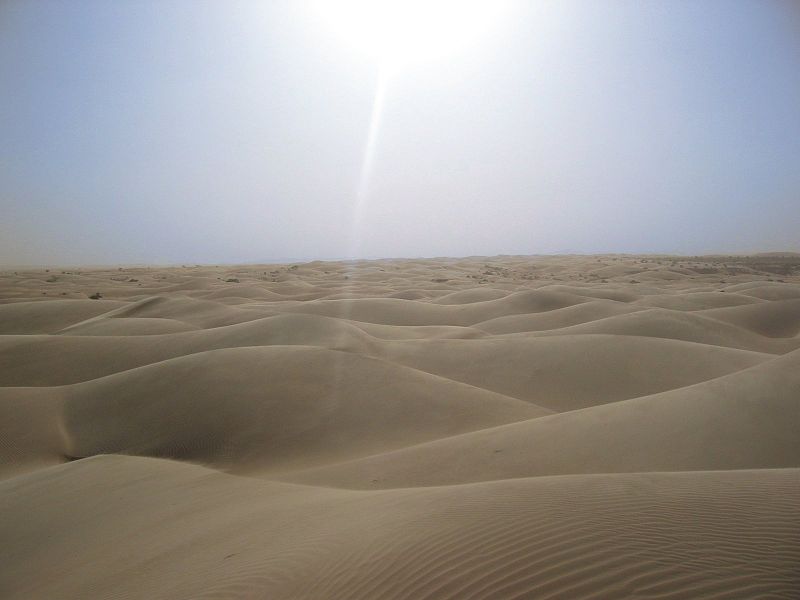
The Sahara Desert is the largest in Africa and the largest warm-weather desert in the world.
©Utilisateur:Jgremillot / CC BY-SA 3.0 – License
The largest desert in Africa is the Sahara. In fact, this is not only the largest desert in Africa but the largest warm-weather desert on Earth, about equal in size to the United States, including Hawaii and Alaska. It is the third largest desert in the world, with only the cold deserts of the Arctic and Antarctica being larger.
The Sahara Desert makes up most of northern Africa. The total area of this desert is about 3,320,000 square miles (8,600,000 square kilometers). From north to south, it measures between 800 and 1,200 miles. From east to west, the desert measures about 3,000 miles.
The area of the desert is not constant. It expands and contracts with the seasons, expanding in the dry winters and contracting during the relatively wet summers.
According to a recent study by the National Science Foundation, the Sahara Desert has actually expanded by approximately 10% since 1920. It’s possible that other deserts are expanding too.
The proposed reason for this expansion is climate change, specifically increasing amounts of aerosols and greenhouse gases in the atmosphere. This is leading to summers getting hotter and rainy seasons not being as wet.
More research needs to be done in order to see how much of this can be attributed to natural climate cycles and how much climate change has been caused by humans.
What Are the Features of the Sahara Desert in Africa?
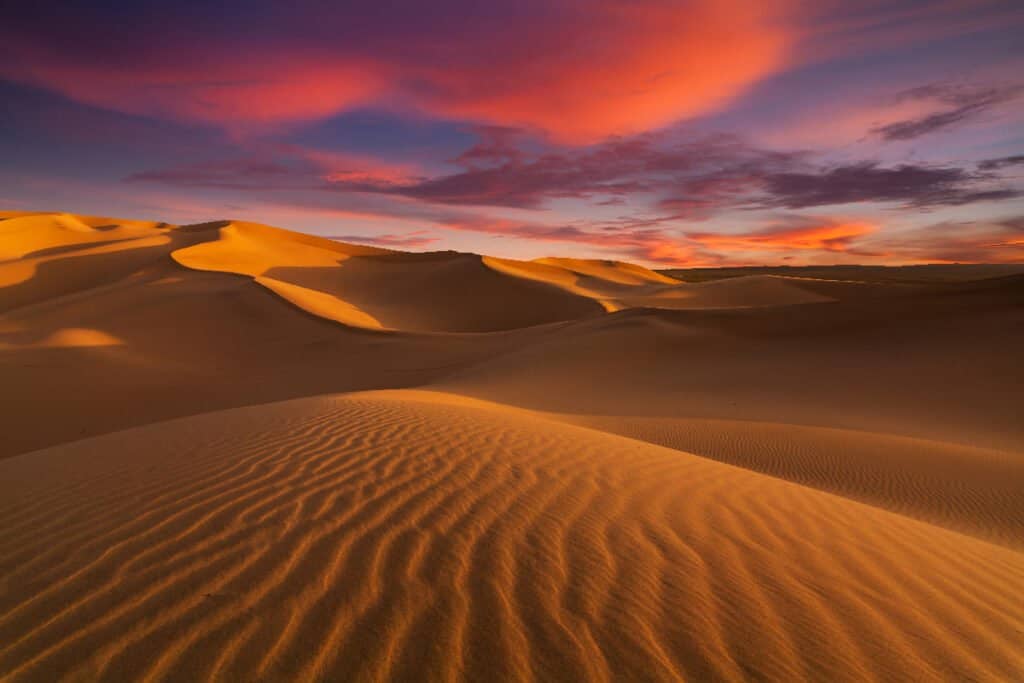
The climate of the Sahara is dry, although there are oases and bodies of water at certain locations.
©Anton Petrus/Shutterstock.com
The Sahara is known to be one of the harshest environments on the planet. However, in terms of imagery, it’s most famous for the huge fields of sand dunes. These sand dunes can be up to almost 600 feet (180 meters) high, and they take up about 25% of the desert.
The Sahara also contains plateaus, mountains, salt flats, depressions, basins, and plains that are covered in either sand or gravel.
The highest point in the Sahara is Emi Koussi, which is an extinct volcano in Chad. This volcano reaches about 11,204 feet (3,415 meters) above sea level. The lowest point, the Qattara Depression in northwestern Egypt, is about 436 feet (133 meters) below sea level.
It is a desert, so water is scarce throughout the Sahara. However, parts of the Niger and Nile Rivers run through the Sahara. There are also many seasonal lakes and large aquifers. The aquifers are the primary water sources for over 90 major oases in the desert.
Although water management authorities once worried that these resources would dry up, a study showed that the aquifers are being consistently fed via runoff and rain.
What Is the Climate of the Sahara Desert in Africa?
Nowadays, the climate in the Sahara is dry and relatively inhospitable. However, many people might be surprised to know that it actually alternates between being the desert that it is now and a lush oasis full of greenery about every 20,000 years.
A 2019 study examined marine sediments that contained dust from the Sahara for the past 240,000 years. They saw that the cycle between different environments in the Sahara corresponded to slight changes in the tilt of the axis of the planet.
When the axis tilted the Northern Hemisphere only one degree closer to the Sun, that area would receive more sunlight and be a green oasis rather than a relatively barren desert.
For the past two millennia, the climate of the Sahara has been pretty dry. There are winds that draw moisture from the air over the Sahara and drive hot air closer to the Equator. These winds can sometimes be very swift and cause huge dust storms.
In 2014, researchers reported that precipitation in the Sahara is typically anywhere between 0 and 3 inches per year. Temperatures year-round are about 60° to 77° Fahrenheit (20° to 25° Celsius), although they can go as high as 120° Fahrenheit (49° Celsius) and as low as 0° Fahrenheit (-18° Celsius).
Animals of the Sahara Desert in Africa
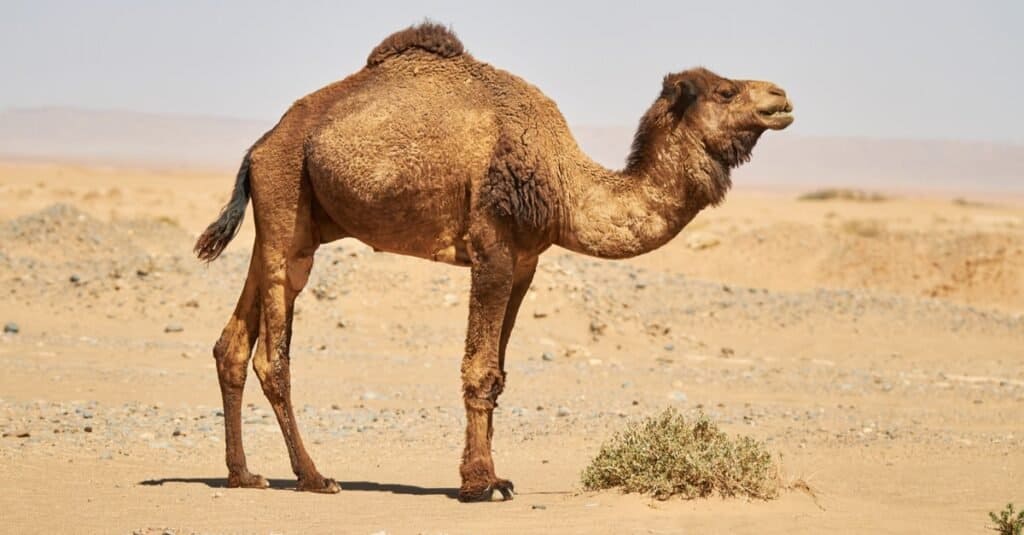
There are hundreds of plant and animal species that have adapted to thrive in the dry environment of the Sahara.
©Photoestetica/Shutterstock.com
It’s easy to assume that just because the Sahara is dry and relatively barren, there is no life there. However, this is far from the case! There are hundreds of species that have adapted to the arid climate and thrived in this environment.
Camels are just one example – even though they are stereotypical animals that inhabit the desert, they actually do here. The humps on their backs store fat, which their bodies use for hydration and energy between meals.
There are also gazelles, cheetahs, desert foxes, wild dogs, and over 60 other mammalian species. There are about 100 reptilian species, including lizards, snakes, and crocodiles.
There are about 90 birds and 500 plant species; oasis areas support various types of grass and shrubs, date palms, and olive trees, among others. In addition to this, there are many scorpions, spiders, and small arthropods, such as beetles and ants.
Up Next
The photo featured at the top of this post is © iStock.com/Eduardo Cabanas
Thank you for reading! Have some feedback for us? Contact the AZ Animals editorial team.



